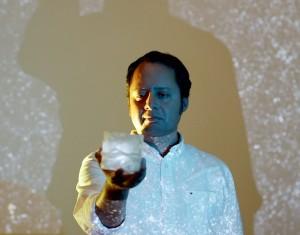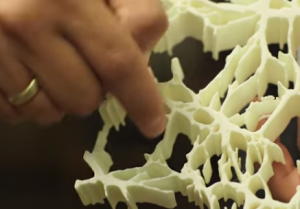 Anything can be 3D printed. That may sound like an exaggeration, but it’s really not. Even the intangible, like light and sound, can be modeled in 3D. Scientists have been using the technology to see and understand things that they couldn’t previously; because of 3D printing’s ability to create perfect replicas of objects and scale them up or down, things as large as comets or as microscopic as pollen particles can be held in the hand. Now a researcher at the University of California Riverside is using 3D printing to study nothing less than the universe itself.
Anything can be 3D printed. That may sound like an exaggeration, but it’s really not. Even the intangible, like light and sound, can be modeled in 3D. Scientists have been using the technology to see and understand things that they couldn’t previously; because of 3D printing’s ability to create perfect replicas of objects and scale them up or down, things as large as comets or as microscopic as pollen particles can be held in the hand. Now a researcher at the University of California Riverside is using 3D printing to study nothing less than the universe itself.
Miguel Aragón-Calvo, a visiting assistant researcher in the university’s Department of Physics and Astronomy, has been studying the formation of the universe for a long time. Currently, he is trying to understand galaxies and their place in the “cosmic web,” which he describes in terms that sound oddly familiar if you’ve spent any time with a 3D printer.
“Galaxies are not isolated objects,” he says. “They are connected through filaments of gas and matter. This gas is injected inside the galaxies through filaments. We see these galaxies forming stars very early. They are forming many stars. And then suddenly, they stop forming the stars. But we don’t know how this happens exactly. I want to identify structures in time.”
 He had been studying these structures using computer simulations, but found that even sophisticated computer technology was insufficient to give him a proper feel for the structures of galaxies and other cosmic objects. So he began 3D printing his 2D simulations, assigning the third dimension to time, which resulted in some very interesting discoveries. For example, one 3D printed galaxy formed a sphere, in which Aragón-Calvo could see filaments twisting as they entered, something he hadn’t been able to see before.
He had been studying these structures using computer simulations, but found that even sophisticated computer technology was insufficient to give him a proper feel for the structures of galaxies and other cosmic objects. So he began 3D printing his 2D simulations, assigning the third dimension to time, which resulted in some very interesting discoveries. For example, one 3D printed galaxy formed a sphere, in which Aragón-Calvo could see filaments twisting as they entered, something he hadn’t been able to see before.
“These problems in cosmology are very difficult to visualize, even using computer graphics,” he says. “By 3D-printing them I am able to interact directly with the models and ‘see’ the problem at once. In some cases this results in ‘eureka’ moments. Tridimensional cosmic structures can be easily identified and tracked as four-dimensional objects where time is taken as another spatial variable. Even though I had visualized the cosmic web many times before in the computer screen, the solution only became obvious once I held the model in my hand.”
 He describes the process as “almost magical,” and it’s hard to disagree. A 3D map of the universe that can be held in the hand allows us to, in a sense, stand outside of our vast surroundings and look inside. How often have you looked up at the Milky Way and admired its beauty, without thinking about its size and position in relation to surrounding objects and galaxies? With a 3D model, it’s suddenly much easier to understand how the elements of the universe interact.
He describes the process as “almost magical,” and it’s hard to disagree. A 3D map of the universe that can be held in the hand allows us to, in a sense, stand outside of our vast surroundings and look inside. How often have you looked up at the Milky Way and admired its beauty, without thinking about its size and position in relation to surrounding objects and galaxies? With a 3D model, it’s suddenly much easier to understand how the elements of the universe interact.
“I often ‘play’ with 3D models of galaxies in their early stages in order to get new ideas on how gas gets injected into them to produce stars,” Aragón-Calvo said. “This has been very helpful in developing a model of galaxy formation that I will soon submit to a peer-reviewed journal.”
Not only has Aragón-Calvo 3D printed the galaxies, he has also, in a way, 3D printed the most intangible thing of all: time. While the aerospace industry is preparing to send people farther into space than ever before, it’s humbling to realize how much about the origins of the universe can be discovered from right here on Earth.
Subscribe to Our Email Newsletter
Stay up-to-date on all the latest news from the 3D printing industry and receive information and offers from third party vendors.
You May Also Like
IperionX Inks 10-Year Deal with Wisconsin Manufacturer for 80 Metric Tons of Titanium Per Year
IperionX, the Charlotte-based supplier of sustainable titanium powders used for additive manufacturing (AM) and metal injection molding (MIM), has signed a ten-year deal with United Stars, a group of industrial...
Gastronology Launches Industrial Production of 3D Printed Food for Dysphagia Patients
Food 3D printing has, in many ways, been an additive manufacturing (AM) segment looking for the right business case. While some applications are beautiful and others may or may not...
Lockheed Martin Leads $3M Investment in Q5D’s Electronics 3D Printing System
Q5D, an original equipment manufacturer (OEM) of robotic arm, hybrid additive manufacturing (AM) systems used for wire harness production, has closed a $3 million investment round. The investment arm of...
3D Printing News Briefs, April 6, 2024: Depowdering, Cybertruck Door Handles, & More
In today’s 3D Printing News Briefs, ioTech’s digital manufacturing CLAD technology is opening up opportunities for microelectronics and additive manufacturing. Hexagon and Raytheon Technologies commercially released the Simufact Additive Process...































